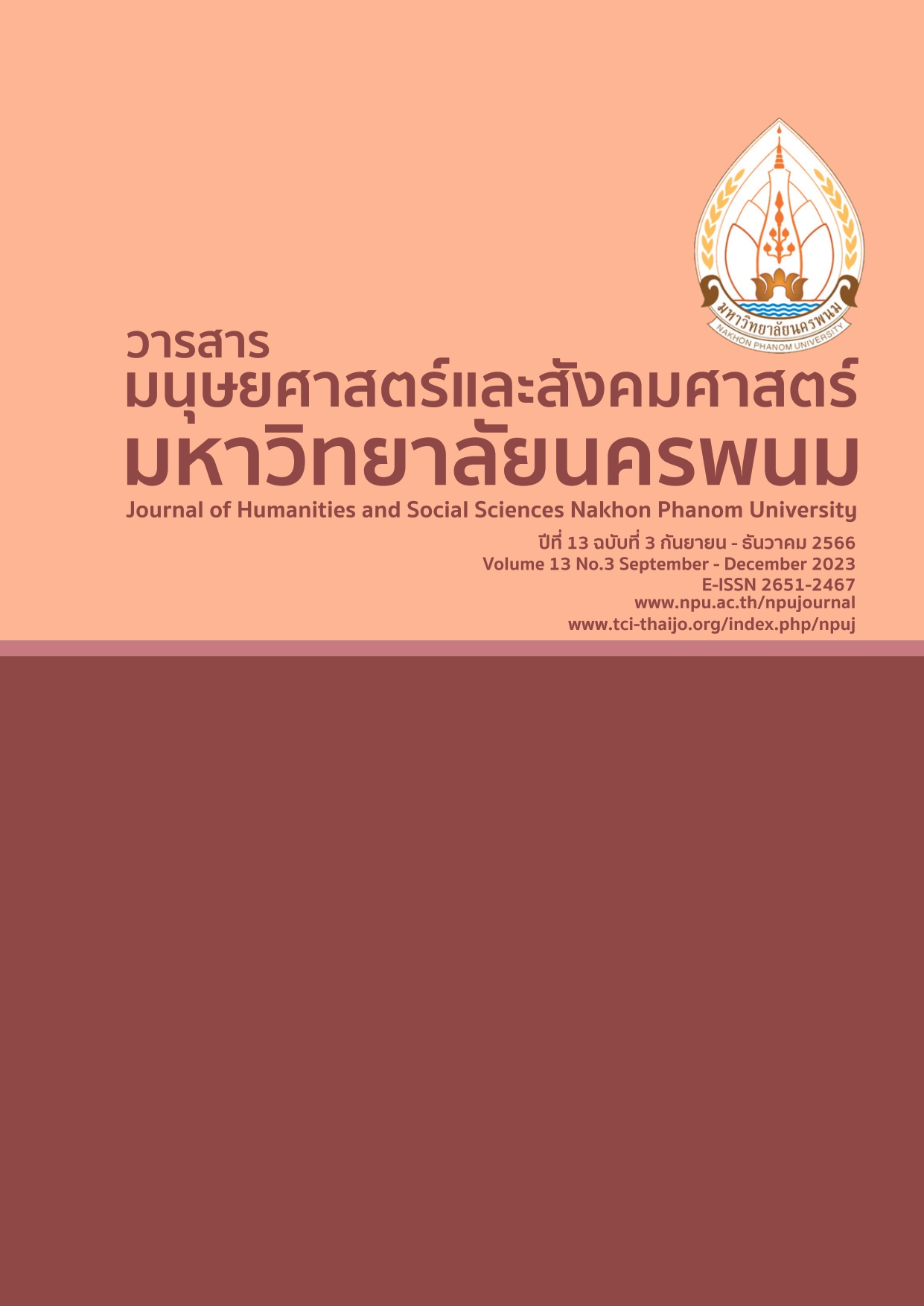Experts’ Perspectives on Female Intimate Partner Violence during the COVID-19 Pandemic
Main Article Content
Abstract
This research aims at studying perspectives of experts on female intimate partner violence during the Covid 19 pandemic. Based on the in-depth interviews with six experts from public sectors and civil society organizations (CSOs) who related prevention operations and problem-solving on female intimate partner violence both in policy and practice. The data was collected between July and November 2022, the results of the interviews found that the female intimate partner violence situation during the COVID 19 pandemic had been rising exceedingly. Female spouses could not ask for any immediate assistance due to a lockdown policy and patriarchal beliefs, which were the important causes of partner violence. There were an increasing number of female partners facing mental and physical violence. Short-term solutions were using mobile applications and hotline telephone. For long-term guidelines, there were five stages, including 1) changing an attitude on intimate partner violence of practitioners; 2) empowering women; 3) changing an attitude toward intimate partner violence of men; 4) promoting a knowledge on gender equity in academic institutions; and 5) working proactively and cooperatively in local areas. If another pandemic occurs again and the implementation of lockdown or social distancing measures must be used, the relevant agencies, including the government, civil society, and communities should work as a network to formulate conjunctive strategies to prevent and solve the problem of female intimate partner violence.
Article Details

This work is licensed under a Creative Commons Attribution-NonCommercial-NoDerivatives 4.0 International License.
References
Agnew, R. and Brezina, T. (2019). General strain theory. Handbook of Crime and Deviance. Retrieve October 2023 from https://doi.org/10.1007/978-3-030-20779-3_8
Ariyapachpol , R. and Woraphattirakul, P. (2020). Kãr kæ̂ pạỵh̄a khwãm runræng nı khrxbkhrạw k̄hxng thịy [The resolution of domestic violence in Thailand]. Journal of Social Science and Buddhistic Anthropology. 5(4): 321-335.
Chaiyawuttho, W. P., Sutthirat, N., and Acharashubho, C. P. (2022). Prãkt̩karn withya [The Phenomenology]. Retrieved June 2023 from https://so05.tci-thaijo.org/index.php/pacific/
article/download/2022-05-24/177429/1004102
Department of Mental Health. (2020). H̄̀wng pạỵh̄a khwãm runræng nı khrxbkhrạw
[Concerning domestic violence problem]. Retrieved August 2021 from https://www.dmh.go.th/
news-dmh/view.asp?id=30544
Department of Women's Affairs and Family Development. (2022). P̄hæn pt̩ibạtikar d̂an kar phạtʹhna s̄tri ph.s. 2566 -2577 [Action plan on women development B.E. 2023 – 2027]. Retrieved March 2023 from https://cpcs.nida.ac.th/home/pdf/allnewcover.pdf
Juangtrakul, J. and Wongprasit, N. (2019). Kar wikheraah̄̒ neụ̄̂xh̄a nı kar wikheraah̄̒ k̄hxmul kar wicạy cheing khunp̣haph [Content analysis for data analysis in qualitative research]. PAATJournal. 2(2): 1-14.
Kongsakon, R. (2008). Khwãmrunræng nı khrxbkhrạw [Domestic violence]. In R. Kongsakon and N. Pocham (Eds.). Khwãmrunræng nı khrxbkhrạw [Domestic violence] (pp. 1-30). Bangkok: Sahaprachapanich.
Ligman, K., Rodriguez, L. M., and Rocek, G. (2021, July). Jealousy and Electronic Intrusion Mediated by Relationship Uncertainty in Married and Cohabiting Couples During COVID-19. Cyberpsychol Behav Soc Netw. 24(7), 444-449. Retrieved September 2023 from https://pubmed.ncbi.nlm.nih.gov/34264772/
Mineo, L. (2022). Shadow pandemic of domestic violence. Retrieved September 2023 from https://news.harvard.edu/gazette/story/2022/06/shadow-pandemic-of-domestic-violence/
Marpraneet, H. (2005). Khwãm runræng nı khrxbkhrạw: P̣hạy k̄hxng p̄huh̄ỵing thi s̄ạngkhm t̂xng rạb ru. [Domestic Violence: A danger on women for social recognition]. P̄huh̄ỵing kạb khwam runræng [Women and violence] (pp. 50-58). Bangkok: The National Council on Social Welfare under the Royal Patronage.
Ministry of Social Development and Human Security. (2022). Rayngan s̄t̄hankarn thang s̄ạngkhm pracả pingbpraman 2564 [Report of social conditions 2022]. Retrieved August 2023 from https://ebooks.m-society.go.th/ebooks/detail/665
Napa, W., Neelapaichit, N., Kongsakorn, R., Chotivitayaragorn, S., and Udomsubpayakul, U. (2023). Impacts of COVID-19 on family violence in Thailand: Prevalence and influencing factors. BMC Women's Health. 23. Retrieved October 2023 from https://doi.org/10.1186/s12905-023-02440-x
Office of Permanent Secretary of Ministry of Social Development and Human Security. (2023). Nwạtkrrm kar cạdkar kæ̂k̄hị pạỵh̄a khwãm runræng nı khrxbkhrạw læa chumchn doy chı̂ chumchn pên suny̒klãng [Innovation solutions for family and community violence by using the community as the center]. Retrieved March 2023 fromhttps://opendata.nesdc.go.th/
dataset/innovative-solutions-for-family-and-community-violence-by-using-the-community-as-the-center
Prasunin, J. and Jitbantao, T. (2022). Khwãm xyuyen pens̄uk̄h nı h̄̂wng s̄t̄hankarn rabad withya kho wid-19læa næwthang kar ld pạỵh̄a khwãm runræng nı khrxbkhrạw [The well-being in the Covid-19: Epidemiological situation and guidelines for reducing domestic violence problems]. Journal of MCU Social Science Review. 11(6),15-29.
Ratchakitcha. (2019). Phrarachbạỵỵạtis̄̀ngs̄erim kar phạtʹhna læa khûmkhrxng s̄t̄habạn khrxbkhrạw Phş 2562 [Family Development Promotion and Protection Act B.E. 2562]. Retrieved July 2023 from
https://www.ratchakitcha.soc.go.th/DATA/PDF/2562/A/067/T_0171.PDF
Ruksee, N., Donjdee, K., Songsiri, N., Deesawas, W., Janjaroen, S., and Yupu, A. (2021). Ar sụks̄ʹa khwamkheriyd khwam witk kạngwl læa s̄ạmphạnthp̣haph nı khrxbkhrạw k̄hxng prachachn thịy p̣hayh̄lạng s̄t̄hankarn kar rabad k̄hxng rokh tid cheụ̄̂x wịrạs̄ khorona 2019 (COVID-19) ralxk ræ [A Study of the stress, anxiety and family relationships among Thai people after the Covid-19 pandemic in the early stages]. Quality of Life and Law Journal. 17(1), 94- 108
Sangkaew, P., Saowane, R., and Haupala, A. (2022). Ars̄ arwc khwãm runræng nı khrxbkhrạw nı s̄t̄hankarn kar phær̀ rabad k̄hxng rokh kho wid 19 krungtheph [The surveys of domestic violence among families in Bangkok during the COVID-19 pandemic]. Ramathibodi Medical Journal. 45(3), 33-41.
Sumra, M., Asghar, S., Khan, K. S., Fernandez-Luna, J., Huete, J. F., and Bueno-Cavanillas, A. (2023). Smartphone apps for domestic violence prevention: A systematic review. International Journal of Environmental Research and Public Health. 20(7), 5246. Retrieved October 2023 from
https://doi.org/10.3390/ijerph20075246
World Health Organization. (2023). Violence against women. Retrieved October 2023 from
https://www.who.int/health-topics/violence-against-women#tab=tab_1
UN Women. (2020a). Facts and figures: Ending violence against women. Retrieved September 2020 from https://www.unwomen.org/en/what-we-do/ending-violence-against-women/facts-and-figures
UN Women. (2020b). COVID-19 and essential services provision for survivors of violence against women and girls. Retrieved September 2020 from https://www.unwomen.org/sites/default/files/
Headquarters/Attachments/Sections/Library/Publications/2020/Brief-COVID-19-and
-essential-services-provision-for-survivors-of-violence-against-women-and-girls-en.pdf
UN Women. (2021). Measuring the shadow pandemic: Violence against women during COVID-19. Retrieved December 2021 from https://data.unwomen.org/sites/default/files/documents/
Publications/Measuring-shadow-pandemic.pdf


